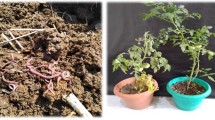Abstract
Studies on critical time of insecticidal protection in relation to damage by aphid, Aphis gossipii Glover and leafhopper, Amrasca biguttula biguttula Ishida on plant growth and yield of okra revealed that 21–42 days after germination, was the most critical time prior to fruiting. Application of carbofuran at the time of sowing was redundant. Effective plant protection 21–42 days after germination resulted in lowest leafhopper and aphid infestation and subsequently the highest benefit to cost ratio.
Résumé
Des études sur le temps critique de la protection d’insecticide en relation avec le ravage par des pous et des sauteurs de feuilles sur la croissance et le rendement de la plante en okra a révélé que 21–42 jours après la germination, d’être le plus critique avant la phase fruitière. L’application de carbofuran au temps des semilles était redondant. Dés méthodes effectives de la protection de plante 21–42 joure après la germination avait pour résultat la moindre infestation des sauteure de feuilles et des pour et par la suite le phis haut avantage économique.
Similar content being viewed by others
References
Anonymous (1982) Pest control in horticultural crops. Indian Institute of Horticultural Research, Extn. Bull. No. 25, p. 44.
Getzin L.W. (1973) Persistence and degradation of carbofuran in soil. Environ. Entomol. 2, 461–467.
Gorder G.W., Dahm P.A. and Tollefson J.J. (1982) Carbofuran persistence in corn field soils. J. econ. Entomol. 75, 637–642.
Krishnaiah K., Ramachander P.R., Jagan Mohan N. and Wahi S.D. (1979) Sampling technique for estimation of jassid population in okra. Indian J. Entomol. 41, 200–202.
Krishnaiah K., Tandon P.L., Mathur, A.C. and Jagan Mohan N. (1976) Evaluation of insecticides for control of major insect pests of okra. Indian J. agric. Sei. 46, 178–186.
Marwaha K.K. and Prakash Swarup (1981) Effect of surface area of granules on the persistence of mephosfolan and carbofuran against freshly hatched larvae of Chilo partellus (Swinhoe). J. Entomol. Res. 1, 50–54.
Radcliffe E.B. and Cancelado R.E. (1979) Potato pest control with soil applied systemic insecticides, 1978. Insecticide Acaricide Tests 4, 96.
Uthamasamy S. (1979) Studies on host resistance to certain okra (Abelmoschus esculentus (L.) Moench) varieties to the leafhopper, Amrasca dévastons (Dist.) (Cicadellidae: Homoptera) Ph. D. Thesis. Tamil Nadu Agricultural University.
Author information
Authors and Affiliations
Additional information
Contribution No. 138/88 of Indian Institute of Horticultural Research.
Rights and permissions
About this article
Cite this article
Kumar, N.K.K., Srintvasan, K. & Sardana, H.R. Evaluation of Time of Insecticidal Application on The Control Of Leafhopper, Amrasca Biguttula Biguttula Ishida (Cicadellidae : Homoptera) and Aphid, Aphis Gossipii Glover (Aphididae : Homoptera) on Okra. Int J Trop Insect Sci 10, 333–339 (1989). https://doi.org/10.1017/S174275840000357X
Received:
Revised:
Published:
Issue Date:
DOI: https://doi.org/10.1017/S174275840000357X




